Heart Of The Matter
From THE QUARTER RACING JOURNAL, June 1998
by Marianna Haun
Research indicates that the female X-chromosome is responsible for the large hearts found in outstanding racehorses.
Secretariat | X, Y and Other Definitions | What Makes a Heart Score?
Big Hearts Can Equal More Money | Research Supports the X-Factor
What Does This Mean for the Quarter Horse? | Great Hearted Horses
Large Hearted Sires Often Panned | Mares Are Most Important | Dash For Cash
Dash For Cash’s Heart | First Down Dash’s Contributions
Other Large Hearted Sires | Man O’War
Trippy Dip
Ever since the first rider challenged another rider to see who had the faster horse, horsemen have described the fastest runners as having “great heart.” The term originally was meant to describe a personality characteristic – something real, but immeasurable, the ability that made a horse dig deep and find the courage not to give up until he crossed the finish line victoriously.
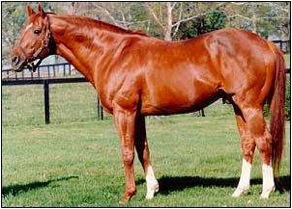
Secretariat
Today, thanks to the truly great heart uncovered at the autopsy of the amazing Thoroughbred Secretariat, it is known that great heart really is a physical description of an extraordinary heart found in certain Thoroughbreds, Quarter Horses and Standardbreds that has passed down the female line on the X chromosome from the legendary Eclipse, foaled in England in 1764.
Following the tradition of burying just the head, heart and hooves of great racehorses, Eclipse was cut open by a London surgeon after his death in 1789. The heart found inside of Eclipse was so much larger than other horses that it was weighed. Eclipse’s great heart weighed 14 pounds, more than twice the normal weight of hearts of horses of that era – approximately six pounds.
Today, the normal weight of a horse’s heart is 8.5 pounds. Even though Secretariat’s heart was not weighed at autopsy, Dr. Thomas Swerczek, head pathologist at the University of Kentucky, estimated it at 22 pounds after finding the second-largest heart in Sham (Secretariat’s Triple Crown rival) and weighing it at 18 pounds.
“I have done thousands of autopsies, and I had noticed differences in heart size in horses before we did Secretariat,” Swerczek said. “I had picked up the difference in the male and female hearts and noticed that some were bigger than others.
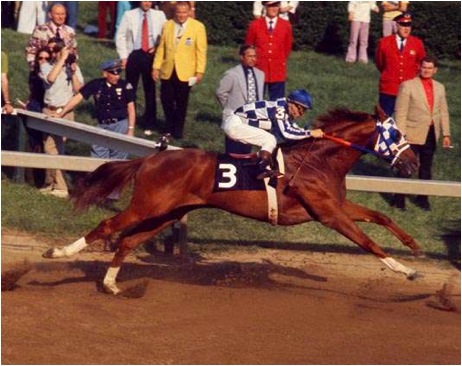
Secretariat winning the Preakness
“But I didn’t pay much attention until Secretariat came along. He was completely out of everybody else’s league. Looking back at what he had done, it was easy to put a connection to it. The heart was what made him able to do what he did. It explained how he was able to do what he did in the Belmont Stakes – a mile and a half race (Secretariat won by 31 lengths in track-record time). You would have to have a large heart to do what he did. It would be impossible for a horse with a small heart to do that.”
|
Large Heart refers to size of the heart. The larger heart corresponds to greater strength and stamina. A normal size heart averages 8.5 pounds. The heart of the great race horse Secretariat was estimated to weigh 22 pounds! The heart of his rival in the Triple Crown, Sham, was weighed at 18 pounds.
|
Recalling the moment Secretariat’s heart was uncovered, Swerczek said, “We just stood there in stunned silence. We couldn’t believe it. The heart was perfect. There were no problems with it. It was just this huge engine.”
For more than 40 years, Australian researchers have studied hearts found in racehorses and have demonstrated a strong pattern of performance correlated with large hearts. The heart of Australian’s greatest runner, Phar Lap, weighed 14 pounds. It is encased in glass in a museum in Australia.
But when Australian researchers tried to relate their findings to U.S. veterinarians in the 1960s, they were laughed at because they couldn’t go out and pick out horses with large hearts. From their studies, they felt that large hearts represented a sex-linked characteristic, with the main influence coming from the dams, but they didn’t know where that characteristic came from.
X, Y and other definitions:
Genetically, there are two sex-linked chromosomes in each horse. Males have an X chromosome, which they receive from their dams and pass to their daughters, and a Y chromosome, which they inherit from their sires and pass to their sons.
The Y chromosome is much smaller than the X chromosome and carries less inheritable material. It is basically a sex determinant and when thrown into the mix at the moment of creation makes that individual a male. If the sire contributes an X chromosome, then the resulting foal is a female.
|
X Factor is a term used to describe the dominant female X chromosome, which is attributed to creating the large hearts. A Single Copy is a broodmare that carries the large heart factor on only one of her X chromosomes. She has a 50% chance of producing a large-hearted colt. A Double Copy broodmare is the ideal! She has both of the dominant large-hearted X chromosomes. If the mare is bred to a large-hearted sire, she will always produce large-hearted foals. Her daughters then will be double copy mares. Double copy mares frequently produce winners.
|
Because the large heart characteristic is on the X chromosome, large-hearted stallions that carry only one X chromosome, which they receive from their dam, can only pass on the large-hearted X chromosome. In the case of their daughters, they carry their sire’s X chromosome and one of the two X chromosomes carried by their dam.
Whichever X chromosome is dominant is the one that is expressed. If a mare is a single copy (meaning she carries the large heart on only one of her X chromosome), she could pass on either the large-hearted X chromosome or the small-hearted X chromosome. Depending upon whichever X chromosome is dominant, that mare might express either a large heart or a small heart.
X Factor – Term that geneticists use to describe the female X chromosome, which is attributed with creating the large hearts found in outstanding racehorses.
Heart score – Term coined by Australian researcher Dr. James Steel to communicate his findings of the heart size on the electrocardiogram, which was gained by a correlation of heart weight, stroke volume, cardiac output and aerobic power.
Double copy – Describes the ideal broodmare, which has the large heart on both X chromosomes. If the mare is bred to a large-hearted sire, she always will produce large-hearted foals. Her daughters also will be double copy mares. Double copy mares frequently produce all winners.
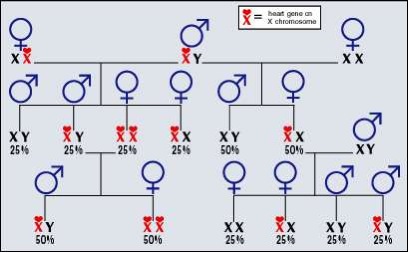 |
One double copy mare is the Thoroughbred Weekend Surprise, a daughter of Secretariat that is out of a double copy dam. Weekend Surprise’s dam, Lassie Dear, produced all winners and so has her daughter, which produced Horse of the Year A.P. Indy and millionaire Summer Squall. Both sires now are producing outstanding daughters, and when mated with large-hearted mares, are producing outstanding sons.
Champion Corona Chick is another double copy mare. She carries the large-hearted X from her sire, Chicks Beduino, which goes to Eclipse through his maternal granddam, Mayshego. On her bottom side, through her dam, Sizzling Lil, Corona Cash has heart lines through Leo and the super heart of Blue Larkspur (TB) through her tail-female line.
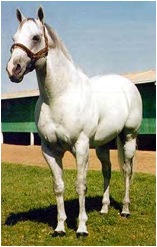
Chicks Beduino
Corona Chick’s daughter champion Corona Cash also will be a double copy mare because she is by the large-hearted sire First Down Dash. Corona Cash should prove to be a good producer like her dam.
Corona Cartel, Corona Chick’s son that earned $557,142 before entering stud this year, also should have a large heart. His daughters should be outstanding, and his sons – if he is bred to large-hearted mares – also should find the winner’s circle.
Single copy – Describes a broodmare that carries a large heart on only one of her X chromosomes.
A famous single copy mare that expressed the large heart, but carried the small heart of her sire on her other X chromosome is Kentucky Derby winner Winning Colors. She was measured and found to have the large heart coming from her maternal granddam, Miss Carmie, which carried one of the four largest heart lines from the famous broodmare sire Blue Larkspur. Winning Colors’ sire, Caro, was found at autopsy to have a small heart.
Breeding Winning Colors to a sire with a normal heart size would increase the possibility of her producing a foal with a small heart.
Following the publication of my first article about Secretariat’s heart in the spring of 1993, I began to search for the source of the great heart. University of Kentucky geneticist Dr. Gus Cothran said that if large hearts were a sex-linked characteristic like the Australians believed, then the characteristic would track to a single source and would be a genetic mutation found on the X chromosome, which passes through the female line.
After months of intense pedigree research, I found a genetic connection on the X chromosome from
Secretariat’s large heart to Eclipse’s large heart that was found at his death exactly 200 years before.
|
The four largest heart lines come from the Thoroughbreds Princequillo, War Admiral, Blue Larkspur and Mahmoud.
|
|
Most large hearts tracked through a mare named Pocahontas, which was foaled in England in 1837, and went to the same daughter of Eclipse, Everlasting, both through her sire, Glencoe, and on her tail-female line.
A few horses track to Eclipse through other Glencoe daughters and through Lexington daughters. The great sire, Domino, carried the large heart of Eclipse through the Glencoe mare Judith and passed it on through his daughters. Lexington, in a recent discovery, was found to descend from an unnamed daughter of Eclipse that was foaled in 1785.
This connection was true for all large hearts found in Thoroughbreds all over the world. Because the breed was founded in England, which for centuries had widespread colonies around the world, Eclipse’s great heart was shipped all over the globe through his daughters. Glencoe, which came to Kentucky after siring Pocahontas in England, spread his large heart through his daughters in America at the same time that Lexington was passing on his heart in America through his daughters.
What makes a “heart score”
Because of the discovery of the importance of the X chromosome in heart size – called the “X Factor” – researchers at the University of Kentucky have been conducting a study to look for the genetic marker for this characteristic.
In the project, more than 400 horses have been measured using an electrocardiogram to measure their heart size and determine a heart score, such as what was used in Australian research. Some 40 years ago, Australian researcher Dr. James Steel coined the term “heart score” to communicate his findings of the heart size on the ECG, which was gained by a correlation of heart weight, stroke volume, cardiac output and aerobic power.
Australian studies rank heart scores in horses according to size. Heart scores of 103 and below are considered small. Heart scores from 104-116 are considered normal. Female hearts from 117 and above are considered large. Male hearts from 120 and above are considered large.
In our study of more than 400 equine hearts, we found heart scores from 100-160. In terms of heart weight, that translates to 6 1/2 pounds to more than 15 pounds. That is quite a range in heart size.
The largest heart in our study, so far, was found in Thoroughbred champion Key to the Mint. He carried the Princequillo heart and had a heart score of 157-160. We also measured an outstanding daughter of Key to the Mint’s that has produced two millionaire daughters, and she had the exact same size of heart as her sire. Most of the Princequillo hearts were between 147-160. The other three super hearts – War Admiral, Blue Larkspur and Mahmoud – were between 140-150. Hearts of 140 and above are considered very large and are generally found in very successful racehorses.
Although we don’t have a heart score on Secretariat, based on his estimated heart weight at the time of autopsy, his heart score would have been around 180. Even in horses carrying the stallion’s heart, we have not found a heart close to that size. It might be that Secretariat, in his heart as well as in his other physical characteristics, was an anomaly. But if his heart hadn’t been so far out of the norm, we never might have discovered what we have about this genetic mutation that produces a high-performance heart.
Big hearts can equal more money
The heart grows until a horse is four years old, and training can add a few points through exercise. While a large heart will not guarantee a winner, studies have shown that it represents approximately 25 percent of what makes
|
The most successful Quarter Horse sires that pass on the large heart have large-hearted Thoroughbred lines on their bottom sides.
|
a champion and is a consistent characteristic. If a horse has a bad attitude, poor conformation or lousy training, a big heart won’t help. But if everything else is in line, a large heart can mean a super horse.
In addition to a pattern of performance, there also is a positive impact on earnings with larger hearts. In scientific studies of trotters conducted in Denmark by Nielsen and Vibe-Petersen of the Royal Veterinary and Agricultural University of Copenhagen, a positive correlation was shown between earnings and high heart scores. In the study, the 41 stallions with heart scores above 115 earned more than double what the 81 stallions with heart scores below 115 earned.
In Standardbreds, the large heart line to Eclipse traces to a mare named Midnight, which was foaled in 1865. She was out of a Thoroughbred mare that was a daughter of Lexington that was out of a daughter of Glencoe, sire of Pocahontas. This mare and two other mares that descend from her on the tail-female line have had a profound influence on the best American trotters. Their heart line can be found in the pedigrees of the highest earners in the breed, including Peace Corps, which earned more than $4.9 million.
However, one interesting fact found in the University of Kentucky study is that the size of the horse doesn’t seem to have any relation to the size of the heart. The largest hearts aren’t necessarily found in the largest horses.
Research supports the X Factor
After measuring more than 400 horses with an ECG, internationally renowned equine cardiologist Dr. Frederic Fregin found the X Factor to be 100 percent consistent, a rarity in scientific research. We have been able to track the large heart from sire to daughter to granddaughter and grandson and to great-granddaughter and great-grandson.
The heart scores on certain lines have been so consistent that we were able to determine which X chromosome was expressed and to identify the four largest “superhearts” found in today’s pedigrees. As mentioned earlier, these four heart lines come from Princequillo, the largest, and from War Admiral, Blue Larkspur and Mahmoud.
While all large hearts track to Eclipse, some lines, whether from genetic modifiers, natural selection or pattern of breeding, have even larger expressions of the large heart found in Eclipse.
What this means for Quarter Horses
Because Quarter Horses long have been crossed with Thoroughbreds, great Quarter Horse runners can have the same great heart as found in great Thoroughbreds. Today, Eclipse’s mighty heart is passed through a number of sires.
The most successful Quarter Horse sires that pass on the large heart have large-hearted Thoroughbred lines on their bottom sides. Thoroughbred heart lines on the top side won’t do any good because the characteristic isn’t on the Y chromosome, which comes from the sire.
In March, Fregin measured two outstanding representatives of both breeds that reside at the Hall of Champions in the Kentucky Horse Park near Lexington. The Thoroughbred was John Henry, a Horse of the Year that earned more than $6.5 million. He was found to have a heart score of 147. The Quarter Horse was Sgt Pepper Feature, a world champion that earned more than $900,000. His heart score was 143.
Based on the Australian study comparing heart score to heart weight at autopsy, these horses each have hearts that weigh between 14 and 15 pounds. That is extraordinary. Both horses, which have hearts larger than Eclipse, tracked to the same heart line, that of the great Double Jay (TB). ECG tracings indicated other similarities in heart rate patterns, further enhancing the possibility that both geldings carry the same heart.
Double Jay is unique for the large heart line because he goes to Eclipse both through Pocahontas and through Lexington through the female side of Audience, the dam of his broodmare sire, Whisk Broom 2nd. Audience’s dam, Sallie McClelland, is a daughter of the great Hindoo, which was out of the Lexington mare Florence. Sallie McClelland’s dam, Red and Blue, was by Alarm, which was out Maud, a daughter of Pocahontas’s son Stockwell.
When I studied the pedigrees of leading Quarter Horse runners, I found it ironic to see a pattern that has haunted the large-hearted individual for centuries. A Thoroughbred stallion might start his stud career in the rich bluegrass of Kentucky, but when he cannot duplicate himself through his son – an impossibility for the large heart – then the spotlight quickly is turned off and he finds himself sent away, frequently to Texas or elsewhere throughout the West and Southwest. Then that great heart, which Kentucky breeders couldn’t wait for, often finds its way into the best Quarter Horses, lengthening their distances and increasing their stamina and speed with superior cardiovascular systems.
The great heart of Eclipse that was uncovered more than 200 years ago still is racing today in three different breeds. It makes sense that most of those hearts come from Eclipse’s daughter Everlasting.
| Great Hearted Horses | |
| A Classic Dash
Aforethought (TB) Alamitos Bar Azure Te (TB) Beduino (TB) Bugs Alive In 75 Calyx Chicaro Bill Chicks Beduino Dash For Cash Dash Thru Traffic David Cox Depth Charge (TB) Diamond Charge Dividend Double Devil Easy Jet First Down Dash Go Man Go Hempen (TB) Holland Ease Jackstraw (TB) Jet Smooth Jonny Apollo Lake Erie (TB) Leo |
Little Request (TB)
Merridoc Mito Paint (TB) Moolah Bux (TB) Moon Deck Pass ’Em Up (TB) Piggin String (TB) Raise Your Glass (TB) Rare Bar Rare Form Rocket Wrangler Ronas Ryon Royal Quick Dash Special Effort Spotted Bull (TB) Streakin Six Takin On The Cash Texas Dancer (TB) The Signature Three Bargains Three Bars (TB) Three Chicks Three Oh’s Tiny Charger Top Deck (TB)
|
Research has proven that the characteristic in racehorses known as “great heart” is really a physical description of an extraordinary heart found in certain Thoroughbreds, Quarter Horses and Standardbreds. From the legendary Eclipse (TB), which was foaled in England in 1764, this great heart has passed down the female line on the X chromosome.
Geneticists use the term “X Factor” to describe the female X chromosome, which is attributed with creating the large hearts found in outstanding racehorses. With an electrocardiogram, researchers can measure the size of a horse’s heart and determine a heart score, which is gained by a correlation of heart weight, stroke volume, cardiac output and aerobic power. Research at the University of Kentucky into the size of more than 400 equine hearts found heart scores ranging from 100-160. In terms of heart weight, that translates to 6 1/2 pounds to more than 15 pounds.
As a result, the X Factor casts doubts on the centuries-old belief that the strength of the stallion determines the athletic potential in racehorses. Because the large heart characteristic is on the X chromosome, large-hearted stallions that carry only one X chromosome (which they receive from their dams) can only pass on the large-hearted X chromosome. Daughters of these stallions carry their sire’s X chromosome and one of the two X chromosomes carried by their dam.
Whichever X chromosome is dominant is the one that is expressed. If a mare is a single copy (meaning she carries the large heart on only one of her X chromosome), she could pass on either the large-hearted X chromosome or the small-hearted X chromosome. Depending upon whichever X chromosome is dominant, that mare might express either a large heart or a small heart.
This information can help breeders ensure that they take full advantage of the X Factor.
Large-hearted sires often panned
|
“For centuries, breeders have observed the phenomenon of certain sires whose best progeny are females whose produce frequently out perform the preceding generation. These sires are called broodmare sires because they sire dams who produce outstanding individuals. Genetically speaking, these sires are passing on their best characteristics on the X chromosome, which they can only give their daughters, who in turn can pass on whatever genetic material is on that chromosome to both their sons and daughters.” Marianna Haun
|
Because the large heart characteristic passes via the female line and the racing industry for centuries has judged a sire by his sons. Large-hearted stallions that accomplished amazing feats on the track often have been panned because they were unable to duplicate themselves in their sons. Extraordinary Thoroughbreds such as Secretariat, Omaha, Citation and Whirlaway are examples.
Man O’ War was an exception because he was lucky enough to be bred to a mare that had a larger heart than he did. That mare, Brushup (TB), was by Sweep, which also gave his high-performance heart to Dustwhirl, dam of Whirlaway.
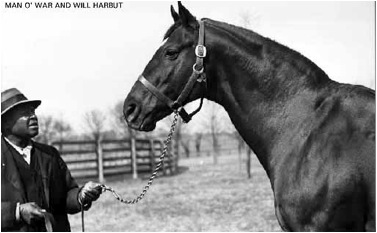
Man O War
Brushup produced Man O’ War’s greatest son, Triple Crown winner War Admiral, which has become one of the four largest heart lines in today’s pedigrees (joining the Thoroughbreds Princequillo, Blue Larkspur and Mahmoud). War Admiral’s heart is in Seattle Slew, broodmare sire of champion Cigar, and also fuels 1997 Kentucky Derby winner Silver Charm.
Large-hearted sires that were successful racehorses have a consistent pattern of producing better daughters than sons – and thus not being appreciated until 10-15 years later, when their daughters begin to produce outstanding racehorses and the stallions are recognized as prolific broodmare sires. If lucky enough to be bred to good mares with large hearts, these stallions then earn the designation of being a sire of sires – ironically taking the credit for
what the mare brought into the mix.
So, the key to making a sire of sires out of a successful large-hearted stallion is to mate him with mares of equal heart size. The resulting colt should have an exceptional cardiovascular system.
Mares are most important
The secret to achieving status as a sire is to get the best mares. The reason the genetic mutation that produces a large heart has made its way down more than 200 years through three different breeds is because of the pattern of breeding the best to the best. Because of the pattern of performance allied to the large heart, breeders have unconsciously been breeding the large heart into their respective breeds.
When selecting mares to be bred to large-hearted Quarter Horse stallions, it is important that breeders remember the tail-female line. The X chromosome the dam sends to her foal doesn’t just come from the broodmare sire – it also can come from the bottom of the dam’s pedigree. Because there is no way of telling which X will be dominant in the genetic spin of the wheel, it is important to cover all genetic bases.
Even with pedigree experts and careful selection of breeding stock, luck still plays a big part in who breeds a champion. There are genetic black holes in many pedigrees that simply can’t be planned against. This is why a double copy mare is so valuable.
There always will be single copy mares that expressed the large heart of their sire, but carried a small heart from their dam. These mares can perform brilliantly on the track, then disappoint in the breeding shed when they are either bred to normal-hearted sires or send the small heart to their sons and daughters.
This is the case with Kentucky Derby winner Winning Colors, a single copy mare that often has sent the small heart to her progeny and hasn’t been able to reproduce herself. Some of Dash For Cash’s best daughters also have had the same problem.
Dash For Speed earned more than $1.2 million, but hasn’t produced up to her potential. The mare, which has some genetic holes in her bottom side for the large heart and is a probable single copy, always should be bred to a large-hearted sire – while a prayer is said for the correct X to come up in the mix!
Daughters of Dash For Speed, such as the two she has by Special Effort, eventually might produce large-hearted individuals. Even if they received the wrong X from Dash For Speed, they will carry the large heart of their sire.
One daughter of Dash For Cash that is a probable double copy mare is Miss Eye Opener. The reason is that she has produced six winners from eight starters and one stakes winner, world champion Special Leader. She carries the large heart of Dash For Cash and is out of a daughter of the large-hearted sire Beduino (TB), which has an outstanding bottom side for the large heart. Her second dam, Ought To Go, is a daughter of the terrific large-hearted sire Go Man Go and is out of a daughter of War Bam, which goes to the large Sweep heart.
As a result, Special Leader is a sire whose daughters should be worth watching as racehorses and broodmares.
Dash For Cash’s daughter Flow Of Cash was a double copy mare that was out of Cherry Lake (TB), a double copy mare that produced four champions when bred to Dash For Cash. Although she only produced two foals before her death, Flow Of Cash, a stakes winner of more than $324,246, did produce a stakes winner in her son Frisco Flare.
Cherry Lake produced six winners from eight starters that earned more than $1.8 million. Following the pattern of double copy daughters from double copy dams, Cherry Lake’s daughter Rain Onya (by Go Man Go), produced double copy Shake It To Em, by Dash For Cash. Shake It To Em continued the pattern, producing eight winners from nine starters, with two stakes winners.
|
Remember that the best producing daughters are not always the best racers, which is true in all breeds. There are many different reasons why some individuals don’t make it on the track: finances, injury, poor training. But these individuals still can carry the genes of champions and can produce.
|
When champion Elan Again was bred to Dash For Cash, she produced the filly Dash Again, an earner of $254,068 that has produced seven winners from eight starters, with three stakes winners and the earners of more than $1.5 million. Dash Again followed her double copy dam’s pattern when she was bred to Special Effort and produced the double copy filly Elans Special, which won the All American Futurity (G1).
Remember that the best producing daughters are not always the best racers, which is true in all breeds. There are many different reasons why some individuals don’t make it on the track: finances, injury, poor training. But these individuals still can carry the genes of champions and can produce.
Two examples of Dash For Cash mares that fit this category are Cypress Point, which never raced, but produced three winners from three starters, including champion Develop A Plan and the earners of more than $390,000; and Cash Balance, dam of stakes winners Six Figures, Fabulous Figure and Six On The Beach, which earned only $425 on the track, but has produced six winners from seven starters with earnings of more than $465,000. She is a probable double copy with large heart lines on all of her pedigree lines.
What some of Dash’s other daughters have done
Merry For Cash, which has a 106 speed index, is another example of a good producing daughter by Dash For Cash. She has seven winners from eight starters and three stakes winners. She probably received the Depth Charge (TB) heart from her broodmare sire, Midway Mayor (TB).
Especially For You is an example of a probable single copy. She didn’t express Dash For Cash’s heart, but had it to give to champion Rare Form, which now can pass it on to his daughters. He already is doing this, siring champion Fabulous Form. He also will sire winning sons, such as champion Especially Rare, when he is bred to mares like Me Bright Special, daughter of large-hearted sire Special Effort.
Dashing Phoebe not only expressed Dash For Cash’s heart and earned $609,554, but when bred to Special Effort produced champion Special Phoebe.
Darlin Dash might not have expressed her sire’s heart, but she produced champion Darlin Sixarun.
Millionaire Make Mine Cash expressed her sire’s heart and produced champion Make Mine Bud. Make Mine Cash has some holes in the bottom side of her pedigree, and that might explain her produce record of 10 foals, eight starters, four winners and one stakes winner.
Dash For Cash’s heart
Judging by the pattern of performance in Quarter Horses with large hearts, the high-performance cardiovascular system is just as important in an animal that reaches his sprinting speed in three strides and never lets up until the finish line.
The most successful Quarter Horse sires that pass on the large heart have large-hearted Thoroughbred lines on their bottom sides. Thoroughbred heart lines on the top side won’t do any good because the characteristic isn’t on the Y chromosome, which comes from the sire.
A prime example of a Quarter Horse with the large Eclipse heart is Dash For Cash. His dam, Find A Buyer (TB), goes to the Eclipse heart on the X chromosome through Whirlaway on the tail-female line through his maternal great-granddam, Scattered, and through his maternal granddam, Hide and Seek, a daughter of Alibhai. An outstanding broodmare sire, Alibhai was found to have a 14-pound heart at autopsy.
All of Dash For Cash’s maternal X chromosome lines go to the Eclipse heart line, but the stallion’s success and the success of his daughters on the racetrack suggest that the heart probably comes from either Whirlaway or Alibhai.
Following the pattern of other successful large-hearted racehorses, most of the big earners by Dash For Cash were female because they were the only ones able to inherit his heart. In studying the pedigrees of the stallion’s best sons, you will find large heart lines in the pedigrees of their dams. In First Down Dash’s case, for example, the large heart comes from his broodmare sire, Gallant Jet, which goes to Eclipse through his second dam, Linda Jewel. She is a daughter of Red Jewel (TB) that goes to Eclipse through Pocahontas on all of his female lines.
The best producers of a large-hearted sire are frequently double copy mares. Dash For Cash’s champion daughter Florentine is a good example. She earned more than $1.1-million and is out of a double copy mare, Trippy Dip (TB), which has large heart lines on all of her X chromosome lines. Trippy Dip is by Scout Leader, which is out of a probable double copy mare, Polylady, that is by the large-hearted sire Polynesian and is out of Lady Dorimar, a granddaughter of Man O’ War. Trippy Dip’s heart lines on her dam’s side are even better.
Her dam, Dancing Straw, is by Dancing Dervish, which is out of Mumtaz, a daughter of Mahmoud – one of the four largest heart lines. Her maternal granddam is the great Jackstraw mare, M. Straw, which demonstrated the pattern of performance and durability found with a superior cardiovascular system when she won a stakes at Ruidoso Downs on September 8, 1963. Twelve days later in Albuquerque, she won a six-furlong race, then was hauled 900 miles to New Braunfels, Texas, where on September 28, she ran the fastest three-eighths of a mile recorded in the state.
Jackstraw carried the large heart lines to Eclipse through his dam, Absurdity. Through her dam, Inquiry, all roads led to Pocahontas through her sons, Stockwell and Rataplan.
Jackstraw also demonstrated the pattern of producing outstanding daughters, including Sea Nymph, his leading earner, and multiple champion Straw Flight. His other outstanding daughters include Fly Straw, Nosey Josey (TB), Kaystorm, Maggie Straw, Cindy Straw, Straw Doll, Straw Lil and Miss Straw. They passed on Jackstraw’s great heart to future generations.
Because of Trippy Dip’s heart line, her champion son, Calyx, should sire nice daughters and sons when bred to large-hearted mares. Like all sires carrying the large heart on their X chromosome, Calyx should be bred to mares with large hearts. Otherwise, he will sire sons with normal to small hearts.
Trippy Dip’s Cinderella story of her rise from the Santa Anita claiming ranks to blue-hen Quarter Horse producer is a good example of the fact that no matter how poorly the world might treat you, you can’t keep good genes down. Lucky for the Quarter Horse breed, Trippy Dip’s worth was realized, and she was crossed with the large-hearted sire Dash For Cash. The rest is history.
First Down Dash’s contributions
First Down Dash is following in his daddy’s footsteps in producing outstanding daughters, such as champions Dashing Folly, Ah Sigh, Corona Cash, Down With Debt, Royal Down Dash and Speedy Empress. These daughters, which have good bottom sides, should be good producers.
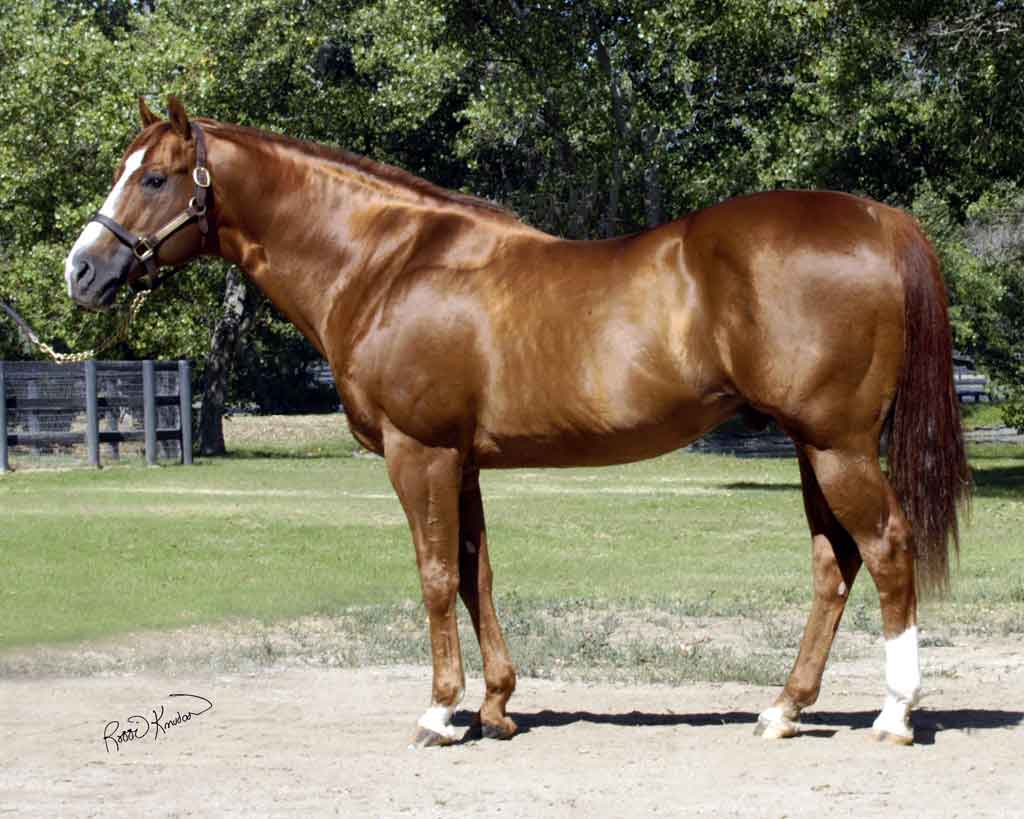
First Down Dash
First Down Dash has been lucky in the mares he has been bred to because most also have had outstanding large heart lines. Champion Dash Thru Traffic is out of Lady Meter Reader, a daughter of large-hearted sire Beduino (TB), whose dam, Jo-Ann-Cat, was a double copy daughter of Rejected out of the Depth Charge mare Quick Eye. Lady Meter Reader also is out of a daughter of Tiny Charger. Dash Thru Traffic’s maternal great-granddam, Rhoda Watch, is a daughter of Anchor Watch (TB), which carries the Sweep heart line.
Champion Royal Quick Dash, another son of First Down Dash, also is out of a Beduino mare, Harems Choice, which is out of a daughter of Tiny Charger. His maternal great-granddam, Hy Flicka, is a daughter of Hysition (TB), which goes to Eclipse through Pocahontas.
A Classic Dash, another champion son of First Down Dash, also comes from a dam with good heart lines. Classic Canyon (TB) is a daughter of Dusty Canyon, which goes to Eclipse through his broodmare sire, Goya 2nd. A Classic Dash’s second dam, Like Grandma, is a daughter of David Cox, which is out of the great Three Bars mare, Miss Myrna Bar.
Grade 1 winner Holland Ease, a son of First Down Dash that earned a 109 speed index, carries plenty of heart through his dam, Easy Henryetta, a daughter of large-hearted sire Easy Jet. Easy Henryetta’s second dam, Baby Steel (TB), is by Leadstealer, which is out of a daughter of the influential Mahmoud.
Other large-hearted sires
Reckless Dash, a son of Dash For Cash, carries the heart line of Raise Your Glass (TB), sire of Special Effort. Although his heart lines won’t help his sons, on the X chromosome line, Raise Your Glass carries the large heart lines of Bull Lea (TB), Sweep and War Admiral through his dam, Champagne Woman.
Streakin Six is another sire with good heart lines. His broodmare sire, Little Request (TB), is a maternal grandson of Sweep. While the bottom of his dam’s pedigree is pretty good, based on his pattern of performance, it is probable that Streakin Six is carrying the Sweep heart.
Carrying the Eclipse heart is champion Ronas Ryon. His dam, Rona Bar, goes to Eclipse through her sire, Three Bargains, which tracks to Lexington twice through his maternal granddam, Marina.
Man O’ War’s influence
In studying the pedigrees of some of the best runners, sires and dams in Quarter Horse racing, I am amazed about the number of great Thoroughbred hearts that are racing in today’s Quarter Horse. Man O’ War is represented in sires such as Spotted Bull (TB), Spy Song (TB) and Moolah Bux (TB). Each stallion was out of a daughter or granddaughter of Man O’ War.
Special Effort is a good example of a Quarter Horse with the Man O’ War heart. His dam, Go Effortlessly, is a daughter of Double Devil, which is out of a daughter of Spotted Bull. Go Effortlessly is inbred to Man O’ War through her dam, Hijo Beauty (TB), another daughter of Spotted Bull.
Special Effort’s son, Strawfly Special, is an example of what can be produced when an outstanding sire is bred to a double copy mare. His dam, Fly In The Pie, produced six starters from six foals, with four winners and one stakes winner. She goes to Eclipse through her sire, Pie In The Sky, which is out of Miss Jelly Roll, a daughter of Roulade (TB), which carries the Sweep (TB) and Alibhai (TB) heart lines. Her dam, Flying Rockette, by Rocket Bar (TB), is out of the great Jackstraw (TB) mare Fly Straw.
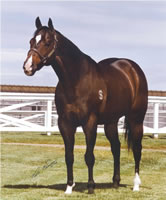
Strawfly Special
The Signature is another sire that carries the Man O’ War heart line through his broodmare sire, Moolah Bux. His second dam, Mable Chick, carries large heart lines to Eclipse through her sire, Triple Chick, and her broodmare sire, Wild Chicle (TB). Judging by the pattern of performance through his female line, it is probable that The Signature expresses the Man O’ War heart.
Merridoc also carries the Man O’ War heart line through Spy Song, which sired his second dam, Tiptoe Tune (TB). Merridoc’s dam, Sparkling Tip, is a probable double copy, carrying the Depth Charge (TB) line through her sire, Diamond Charge, and going to two large-hearted sires on her bottom side, Bolero (TB) and Spy Song.
Following the pattern of large-hearted sires, Merridoc has sired a champion daughter, St Willa. He is also the broodmare sire of world champion Down With Debt. Because she is by First Down Dash, Down With Debt could be a double copy mare. So far, she has three starters and two winners.
Another large-hearted sire that has made himself felt on heart lines of top Quarter Horses is Hempen (TB), which goes to both Man O’ War and his great son, War Admiral. Hempen is found on the X chromosome lines of champion Dashing Folly through his daughter Hempes Folly. Another champion by First Down Dash is Speedy Empress, which has Hempen as her maternal great-grandsire.
The Hempen heart line can be found in sons of First Down Dash as well. Grade 1 winner Rakin In The Cash, which entered stud this year, is out of a Hempen mare, and Leaving Memories is also out of a daughter of Hempen.
When it comes to great heart, Man O’ War had plenty to spare, and he spread that great heart to both Thoroughbreds and Quarter Horses.
2 Responses to Heart Of The Matter